Business Intelligence and Data Warehousing: Benefits Analysis Report
VerifiedAdded on 2023/06/08
|23
|5230
|276
Report
AI Summary
This report provides a comprehensive overview of data analytics and its significant advantages for organizations. It begins with an executive summary highlighting the importance of data as a key asset and the evolution of data analysis tools. The report then delves into the core benefits, including data visualization, which aids in understanding complex patterns; the creation of detailed customer profiles for personalized experiences; and the importance of data-driven decision-making for automation and optimization. Furthermore, it explores the benefits of data diversity, allowing businesses to integrate various data sources; the generation of valuable insights to improve decision-making; the ability to overcome reimbursement challenges in the medical field; and the proactive anticipation of customer needs. The report also covers the role of data analytics in mitigating risks and enhancing overall security. The discussion part highlights the importance of data and its impact on organizational operations, further elaborating on the benefits provided by data analytics. The assignment addresses the core concepts and provides a detailed analysis of the topics, concluding with a summary of the key findings and references.

Running Head: BUSINESS INTELLIGENT AND WAREHOUSE
BUSINESS INTELLIGENT AND WAREHOUSE
Name of Student
Name of University
Author’s Note
BUSINESS INTELLIGENT AND WAREHOUSE
Name of Student
Name of University
Author’s Note
Paraphrase This Document
Need a fresh take? Get an instant paraphrase of this document with our AI Paraphraser

1BUSINESS INTELLIGENT AND WAREHOUSE
Executive summary
Information is the most important asset that an organization consists. Previously,
collecting as well as storing data was the main issue faced by the organizations. Nowadays there
are huge amount of data, unstructured as well as structured that require analysis in a time
sensitive and iterative way. As a result, tools for data analysis have been introduced to solve the
issues. Organizations need be very well positioned in order to take the advantages of data
analytics tools. This report discusses regarding data analytics and its advantages. It describes in
details the benefits provided by data analytics to the organizations.
Executive summary
Information is the most important asset that an organization consists. Previously,
collecting as well as storing data was the main issue faced by the organizations. Nowadays there
are huge amount of data, unstructured as well as structured that require analysis in a time
sensitive and iterative way. As a result, tools for data analysis have been introduced to solve the
issues. Organizations need be very well positioned in order to take the advantages of data
analytics tools. This report discusses regarding data analytics and its advantages. It describes in
details the benefits provided by data analytics to the organizations.
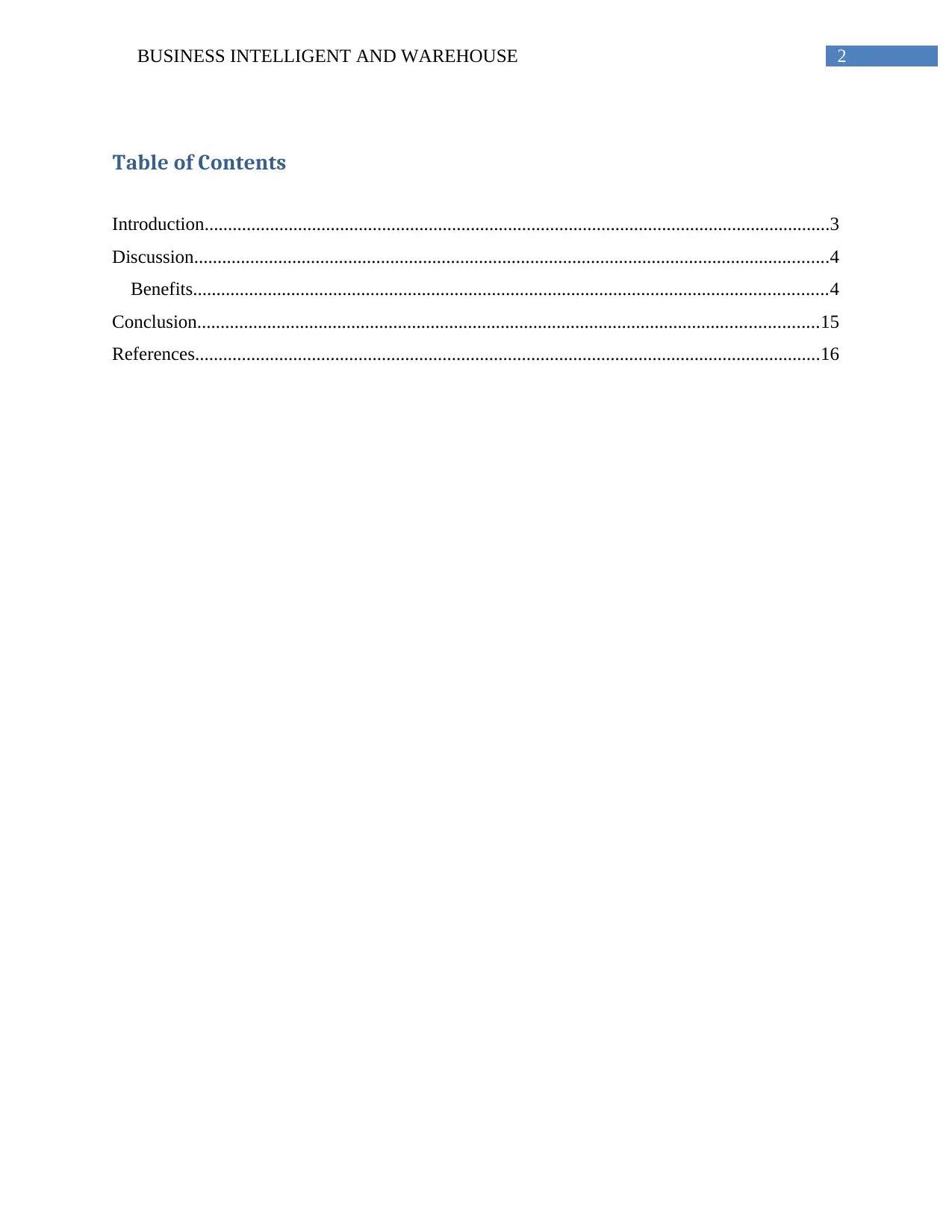
2BUSINESS INTELLIGENT AND WAREHOUSE
Table of Contents
Introduction......................................................................................................................................3
Discussion........................................................................................................................................4
Benefits........................................................................................................................................4
Conclusion.....................................................................................................................................15
References......................................................................................................................................16
Table of Contents
Introduction......................................................................................................................................3
Discussion........................................................................................................................................4
Benefits........................................................................................................................................4
Conclusion.....................................................................................................................................15
References......................................................................................................................................16
⊘ This is a preview!⊘
Do you want full access?
Subscribe today to unlock all pages.

Trusted by 1+ million students worldwide
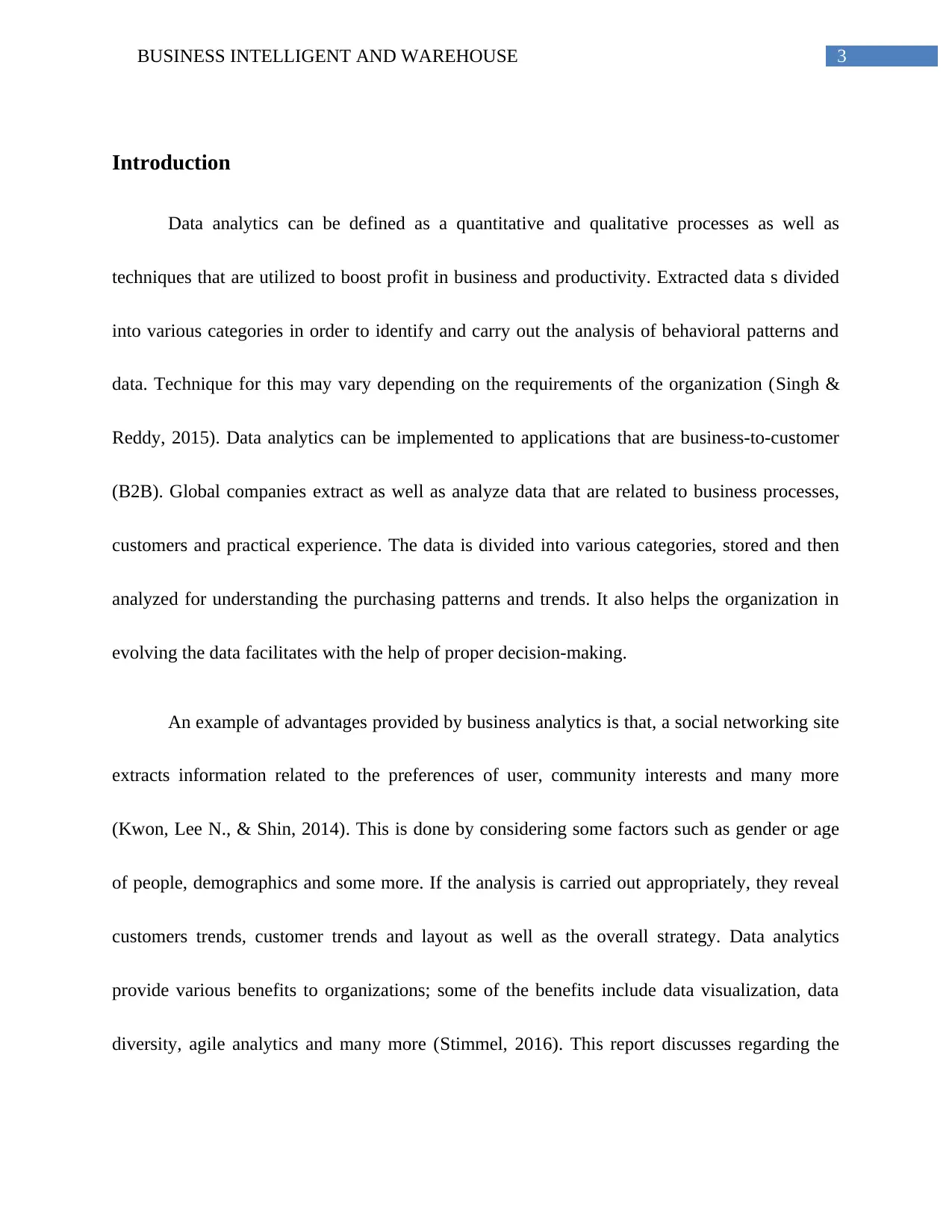
3BUSINESS INTELLIGENT AND WAREHOUSE
Introduction
Data analytics can be defined as a quantitative and qualitative processes as well as
techniques that are utilized to boost profit in business and productivity. Extracted data s divided
into various categories in order to identify and carry out the analysis of behavioral patterns and
data. Technique for this may vary depending on the requirements of the organization (Singh &
Reddy, 2015). Data analytics can be implemented to applications that are business-to-customer
(B2B). Global companies extract as well as analyze data that are related to business processes,
customers and practical experience. The data is divided into various categories, stored and then
analyzed for understanding the purchasing patterns and trends. It also helps the organization in
evolving the data facilitates with the help of proper decision-making.
An example of advantages provided by business analytics is that, a social networking site
extracts information related to the preferences of user, community interests and many more
(Kwon, Lee N., & Shin, 2014). This is done by considering some factors such as gender or age
of people, demographics and some more. If the analysis is carried out appropriately, they reveal
customers trends, customer trends and layout as well as the overall strategy. Data analytics
provide various benefits to organizations; some of the benefits include data visualization, data
diversity, agile analytics and many more (Stimmel, 2016). This report discusses regarding the
Introduction
Data analytics can be defined as a quantitative and qualitative processes as well as
techniques that are utilized to boost profit in business and productivity. Extracted data s divided
into various categories in order to identify and carry out the analysis of behavioral patterns and
data. Technique for this may vary depending on the requirements of the organization (Singh &
Reddy, 2015). Data analytics can be implemented to applications that are business-to-customer
(B2B). Global companies extract as well as analyze data that are related to business processes,
customers and practical experience. The data is divided into various categories, stored and then
analyzed for understanding the purchasing patterns and trends. It also helps the organization in
evolving the data facilitates with the help of proper decision-making.
An example of advantages provided by business analytics is that, a social networking site
extracts information related to the preferences of user, community interests and many more
(Kwon, Lee N., & Shin, 2014). This is done by considering some factors such as gender or age
of people, demographics and some more. If the analysis is carried out appropriately, they reveal
customers trends, customer trends and layout as well as the overall strategy. Data analytics
provide various benefits to organizations; some of the benefits include data visualization, data
diversity, agile analytics and many more (Stimmel, 2016). This report discusses regarding the
Paraphrase This Document
Need a fresh take? Get an instant paraphrase of this document with our AI Paraphraser

4BUSINESS INTELLIGENT AND WAREHOUSE
benefits provided by data analytics to organizations. The benefits are described in details in the
discussion part of the report.
Discussion
The main asset of every organization is the data that it consists; data is the most important
resource that an organization owns. Abundance of information changes the way an organization
operates (Wang, Kung & Byrd, 2018). Data can be used to have insights that help the
organization to take better decisions. There are various benefits that data analytics provide to the
organizations.
Benefits
The benefits provided by data analytics to organizations are as follows
Data visualization: Raw data is extracted with volume as well as velocity. Data
represented in graphical format is considered to be insightful compared to the
representation done by numbering the sectors. This is the reason why data representation
is very important (Kambatla, Kollias & Kumar, 2014). It helps any employee belonging
to an organization to understand tough concepts and identify various unique patterns
within the information available. They do not need to carry out complex analysis. The
capacity of visualizing data is often considered as a tool that is good to have within an
benefits provided by data analytics to organizations. The benefits are described in details in the
discussion part of the report.
Discussion
The main asset of every organization is the data that it consists; data is the most important
resource that an organization owns. Abundance of information changes the way an organization
operates (Wang, Kung & Byrd, 2018). Data can be used to have insights that help the
organization to take better decisions. There are various benefits that data analytics provide to the
organizations.
Benefits
The benefits provided by data analytics to organizations are as follows
Data visualization: Raw data is extracted with volume as well as velocity. Data
represented in graphical format is considered to be insightful compared to the
representation done by numbering the sectors. This is the reason why data representation
is very important (Kambatla, Kollias & Kumar, 2014). It helps any employee belonging
to an organization to understand tough concepts and identify various unique patterns
within the information available. They do not need to carry out complex analysis. The
capacity of visualizing data is often considered as a tool that is good to have within an
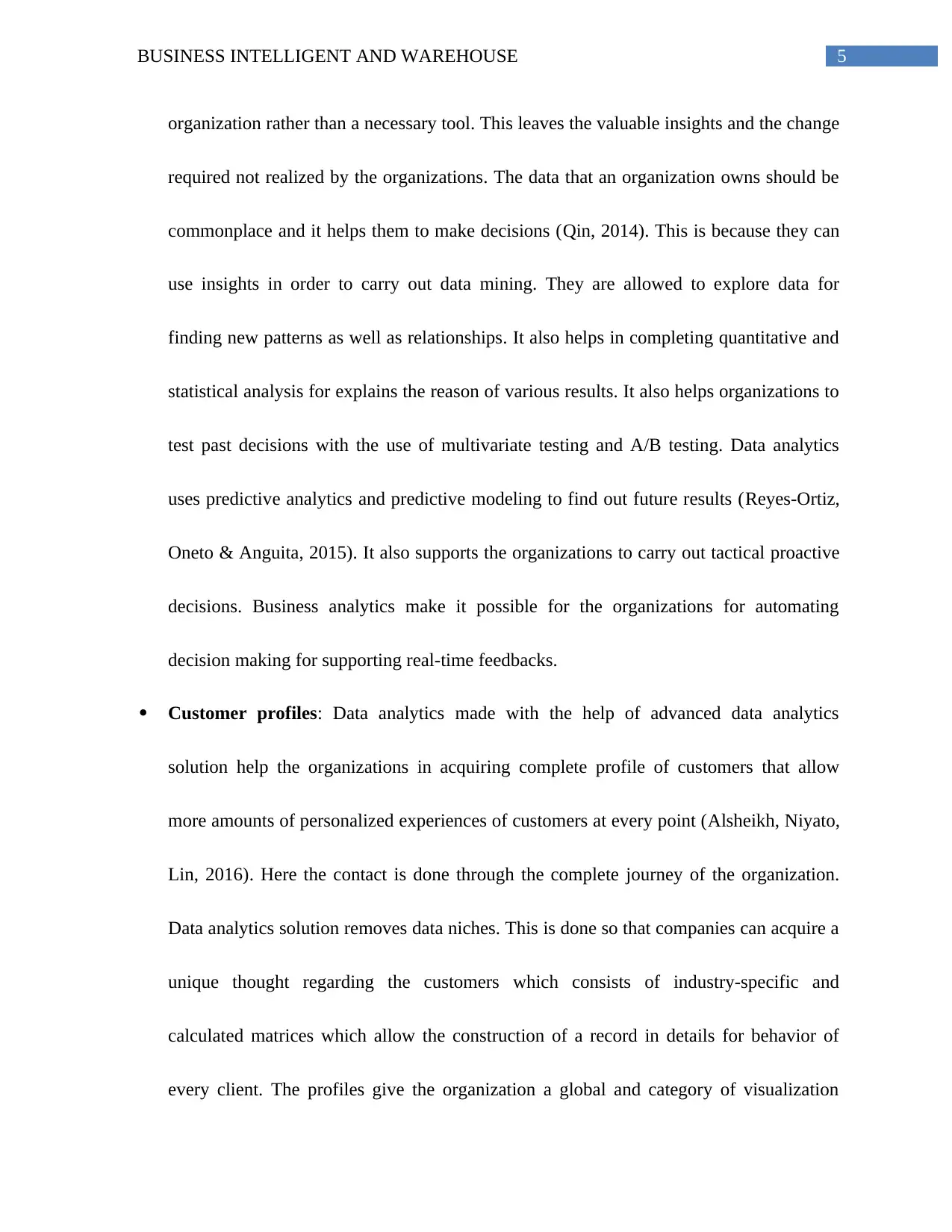
5BUSINESS INTELLIGENT AND WAREHOUSE
organization rather than a necessary tool. This leaves the valuable insights and the change
required not realized by the organizations. The data that an organization owns should be
commonplace and it helps them to make decisions (Qin, 2014). This is because they can
use insights in order to carry out data mining. They are allowed to explore data for
finding new patterns as well as relationships. It also helps in completing quantitative and
statistical analysis for explains the reason of various results. It also helps organizations to
test past decisions with the use of multivariate testing and A/B testing. Data analytics
uses predictive analytics and predictive modeling to find out future results (Reyes-Ortiz,
Oneto & Anguita, 2015). It also supports the organizations to carry out tactical proactive
decisions. Business analytics make it possible for the organizations for automating
decision making for supporting real-time feedbacks.
Customer profiles: Data analytics made with the help of advanced data analytics
solution help the organizations in acquiring complete profile of customers that allow
more amounts of personalized experiences of customers at every point (Alsheikh, Niyato,
Lin, 2016). Here the contact is done through the complete journey of the organization.
Data analytics solution removes data niches. This is done so that companies can acquire a
unique thought regarding the customers which consists of industry-specific and
calculated matrices which allow the construction of a record in details for behavior of
every client. The profiles give the organization a global and category of visualization
organization rather than a necessary tool. This leaves the valuable insights and the change
required not realized by the organizations. The data that an organization owns should be
commonplace and it helps them to make decisions (Qin, 2014). This is because they can
use insights in order to carry out data mining. They are allowed to explore data for
finding new patterns as well as relationships. It also helps in completing quantitative and
statistical analysis for explains the reason of various results. It also helps organizations to
test past decisions with the use of multivariate testing and A/B testing. Data analytics
uses predictive analytics and predictive modeling to find out future results (Reyes-Ortiz,
Oneto & Anguita, 2015). It also supports the organizations to carry out tactical proactive
decisions. Business analytics make it possible for the organizations for automating
decision making for supporting real-time feedbacks.
Customer profiles: Data analytics made with the help of advanced data analytics
solution help the organizations in acquiring complete profile of customers that allow
more amounts of personalized experiences of customers at every point (Alsheikh, Niyato,
Lin, 2016). Here the contact is done through the complete journey of the organization.
Data analytics solution removes data niches. This is done so that companies can acquire a
unique thought regarding the customers which consists of industry-specific and
calculated matrices which allow the construction of a record in details for behavior of
every client. The profiles give the organization a global and category of visualization
⊘ This is a preview!⊘
Do you want full access?
Subscribe today to unlock all pages.

Trusted by 1+ million students worldwide
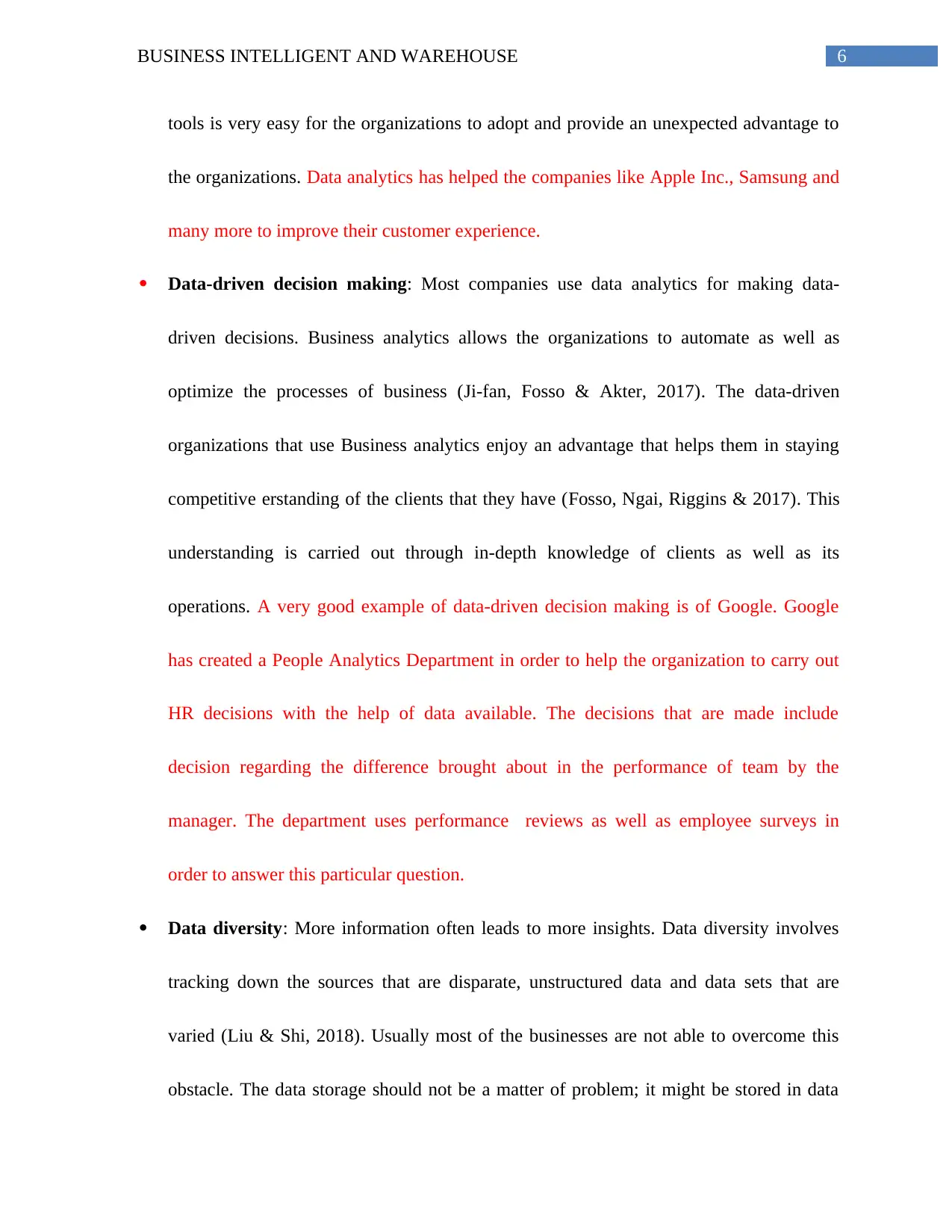
6BUSINESS INTELLIGENT AND WAREHOUSE
tools is very easy for the organizations to adopt and provide an unexpected advantage to
the organizations. Data analytics has helped the companies like Apple Inc., Samsung and
many more to improve their customer experience.
Data-driven decision making: Most companies use data analytics for making data-
driven decisions. Business analytics allows the organizations to automate as well as
optimize the processes of business (Ji-fan, Fosso & Akter, 2017). The data-driven
organizations that use Business analytics enjoy an advantage that helps them in staying
competitive erstanding of the clients that they have (Fosso, Ngai, Riggins & 2017). This
understanding is carried out through in-depth knowledge of clients as well as its
operations. A very good example of data-driven decision making is of Google. Google
has created a People Analytics Department in order to help the organization to carry out
HR decisions with the help of data available. The decisions that are made include
decision regarding the difference brought about in the performance of team by the
manager. The department uses performance reviews as well as employee surveys in
order to answer this particular question.
Data diversity: More information often leads to more insights. Data diversity involves
tracking down the sources that are disparate, unstructured data and data sets that are
varied (Liu & Shi, 2018). Usually most of the businesses are not able to overcome this
obstacle. The data storage should not be a matter of problem; it might be stored in data
tools is very easy for the organizations to adopt and provide an unexpected advantage to
the organizations. Data analytics has helped the companies like Apple Inc., Samsung and
many more to improve their customer experience.
Data-driven decision making: Most companies use data analytics for making data-
driven decisions. Business analytics allows the organizations to automate as well as
optimize the processes of business (Ji-fan, Fosso & Akter, 2017). The data-driven
organizations that use Business analytics enjoy an advantage that helps them in staying
competitive erstanding of the clients that they have (Fosso, Ngai, Riggins & 2017). This
understanding is carried out through in-depth knowledge of clients as well as its
operations. A very good example of data-driven decision making is of Google. Google
has created a People Analytics Department in order to help the organization to carry out
HR decisions with the help of data available. The decisions that are made include
decision regarding the difference brought about in the performance of team by the
manager. The department uses performance reviews as well as employee surveys in
order to answer this particular question.
Data diversity: More information often leads to more insights. Data diversity involves
tracking down the sources that are disparate, unstructured data and data sets that are
varied (Liu & Shi, 2018). Usually most of the businesses are not able to overcome this
obstacle. The data storage should not be a matter of problem; it might be stored in data
Paraphrase This Document
Need a fresh take? Get an instant paraphrase of this document with our AI Paraphraser

7BUSINESS INTELLIGENT AND WAREHOUSE
warehouse, in Hadoop, in desktop, in excel or cloud. The data might be structured,
unstructured or semi-structure. An example of this is that, Unilever has combined sales,
social data and weather for optimizing advertizing in the marketing strategies. If the
organizations keep employing the tools of data blending such as Alteryx, they can
remove the space between the sources (Chen, Preston & Swink, 2015). A represent able
process can be created which would consume only minutes and not weeks for refreshing.
This process can be created by improving delivery approach.
Provide ideas: Data analytics has the capability to provide ideas from an unlimited
amount of information from various sources which include the ones that are received
from the third party sources, social networks, and the information stored in database of
the company, from internet and many more (Fan, Lau & Zhao, 2015). Real-time
monitoring as well as forecasting of various occasions which hold the chances of
affecting the operations or performance of the organizations. With the help of data
analytics, organizations are allowed to locate, extract, get, change, blend and analyze data
with the help of various tools. It also helps the companies to identify important data
which can improve the type of decision making (Marr, 2015). It also helps the
organization to mitigate numerous risks by optimizing various difficult decisions
regarding events that are not planned. Identifying the reasons of failures and issues in real
time. Complete understanding of the capacity of marking that is data-driven. Customers
warehouse, in Hadoop, in desktop, in excel or cloud. The data might be structured,
unstructured or semi-structure. An example of this is that, Unilever has combined sales,
social data and weather for optimizing advertizing in the marketing strategies. If the
organizations keep employing the tools of data blending such as Alteryx, they can
remove the space between the sources (Chen, Preston & Swink, 2015). A represent able
process can be created which would consume only minutes and not weeks for refreshing.
This process can be created by improving delivery approach.
Provide ideas: Data analytics has the capability to provide ideas from an unlimited
amount of information from various sources which include the ones that are received
from the third party sources, social networks, and the information stored in database of
the company, from internet and many more (Fan, Lau & Zhao, 2015). Real-time
monitoring as well as forecasting of various occasions which hold the chances of
affecting the operations or performance of the organizations. With the help of data
analytics, organizations are allowed to locate, extract, get, change, blend and analyze data
with the help of various tools. It also helps the companies to identify important data
which can improve the type of decision making (Marr, 2015). It also helps the
organization to mitigate numerous risks by optimizing various difficult decisions
regarding events that are not planned. Identifying the reasons of failures and issues in real
time. Complete understanding of the capacity of marking that is data-driven. Customers

8BUSINESS INTELLIGENT AND WAREHOUSE
are provided with various offers depending on their buying habits. It improves
commitment of client and increases their level of loyalty. Revolution of risks portfolio is
carried out in n time. It also helps the organization to customize the experience of
customers (Khan, Anjum & Soomro, 2015). Organizations can also add value to
interactions taking place with the online as well as online customers.
Overcoming challenges that are reimbursement: data analytics provide advantages in
various businesses. It helps the medical field as well (Diamantoulakis, Kapina &
Karagiannidis, 2015). It helps the medical fields by overcoming challenges that are
reimbursement-based. Information storage as well as reporting is very important for the
providers that are looking for showing results. Every medical institute changes their
incentives structure and payment systems. Providers are supposed to adapt by the clinical
analytics as well as tools of business intelligence (Park, Nguyen & Won, 2015). This
helps the institute sin various ways such as payer underpayment, data-driven approach
and pricing transparency. Underpayments lead to claims auditing and higher billing that
are inefficient. It also leads to costs of contract administration. Usage of effective data
analytics, providers are able to ensure the accuracy of payment and complete
reimbursements. Following an outstanding strategy of data-driven approach allows in
claiming increased accuracy and assessment process (Ahmed, Yaqoob & Hashem, et al.,
2017). Employees want increased transparency, providers should strive in order to keep a
are provided with various offers depending on their buying habits. It improves
commitment of client and increases their level of loyalty. Revolution of risks portfolio is
carried out in n time. It also helps the organization to customize the experience of
customers (Khan, Anjum & Soomro, 2015). Organizations can also add value to
interactions taking place with the online as well as online customers.
Overcoming challenges that are reimbursement: data analytics provide advantages in
various businesses. It helps the medical field as well (Diamantoulakis, Kapina &
Karagiannidis, 2015). It helps the medical fields by overcoming challenges that are
reimbursement-based. Information storage as well as reporting is very important for the
providers that are looking for showing results. Every medical institute changes their
incentives structure and payment systems. Providers are supposed to adapt by the clinical
analytics as well as tools of business intelligence (Park, Nguyen & Won, 2015). This
helps the institute sin various ways such as payer underpayment, data-driven approach
and pricing transparency. Underpayments lead to claims auditing and higher billing that
are inefficient. It also leads to costs of contract administration. Usage of effective data
analytics, providers are able to ensure the accuracy of payment and complete
reimbursements. Following an outstanding strategy of data-driven approach allows in
claiming increased accuracy and assessment process (Ahmed, Yaqoob & Hashem, et al.,
2017). Employees want increased transparency, providers should strive in order to keep a
⊘ This is a preview!⊘
Do you want full access?
Subscribe today to unlock all pages.

Trusted by 1+ million students worldwide

9BUSINESS INTELLIGENT AND WAREHOUSE
constant balance between value and cost without compromising on the quality. One more
advantage provided by data analytics to the medical field is flexible IT. It provides a
backend which collects data from various sources. Some data collected include clinical
data, tests, and medical histories, records regarding procedures carried out, diagnoses,
medication, inpatient as well as ambulatory records and images. This contributes in
providing better results. It helps in increasing the level of data access beyond a particular
individual (Zhao, Fan & Hu, 2014). This as a result, helps in taking better decisions and
increase in personalized care.
Anticipating and proactive needs: Organizations face a huge level pressure due to the
competition that has been going on in the market between various companies (Hu &
Vasilakos, 2016). The competitive pressure creates an additional pressure on the
organizations of understanding the requirements of customers and the ability of
optimizing experience of customers as well as maintains a healthy relationship among
them which would last long. Organizations share their data and allow the customers a
relaxed privacy while they use the website of the organization. This convinces the
customers on the fact that the organization knows customers through various interactions
and allows a seamless and perfect experience (Choi, Chan & Yue, 2017). For this
purpose, the organizations require to reconcile and capture different identifies of
customers like email, addresses and cell phones into a single ID. This IFD would be
constant balance between value and cost without compromising on the quality. One more
advantage provided by data analytics to the medical field is flexible IT. It provides a
backend which collects data from various sources. Some data collected include clinical
data, tests, and medical histories, records regarding procedures carried out, diagnoses,
medication, inpatient as well as ambulatory records and images. This contributes in
providing better results. It helps in increasing the level of data access beyond a particular
individual (Zhao, Fan & Hu, 2014). This as a result, helps in taking better decisions and
increase in personalized care.
Anticipating and proactive needs: Organizations face a huge level pressure due to the
competition that has been going on in the market between various companies (Hu &
Vasilakos, 2016). The competitive pressure creates an additional pressure on the
organizations of understanding the requirements of customers and the ability of
optimizing experience of customers as well as maintains a healthy relationship among
them which would last long. Organizations share their data and allow the customers a
relaxed privacy while they use the website of the organization. This convinces the
customers on the fact that the organization knows customers through various interactions
and allows a seamless and perfect experience (Choi, Chan & Yue, 2017). For this
purpose, the organizations require to reconcile and capture different identifies of
customers like email, addresses and cell phones into a single ID. This IFD would be
Paraphrase This Document
Need a fresh take? Get an instant paraphrase of this document with our AI Paraphraser
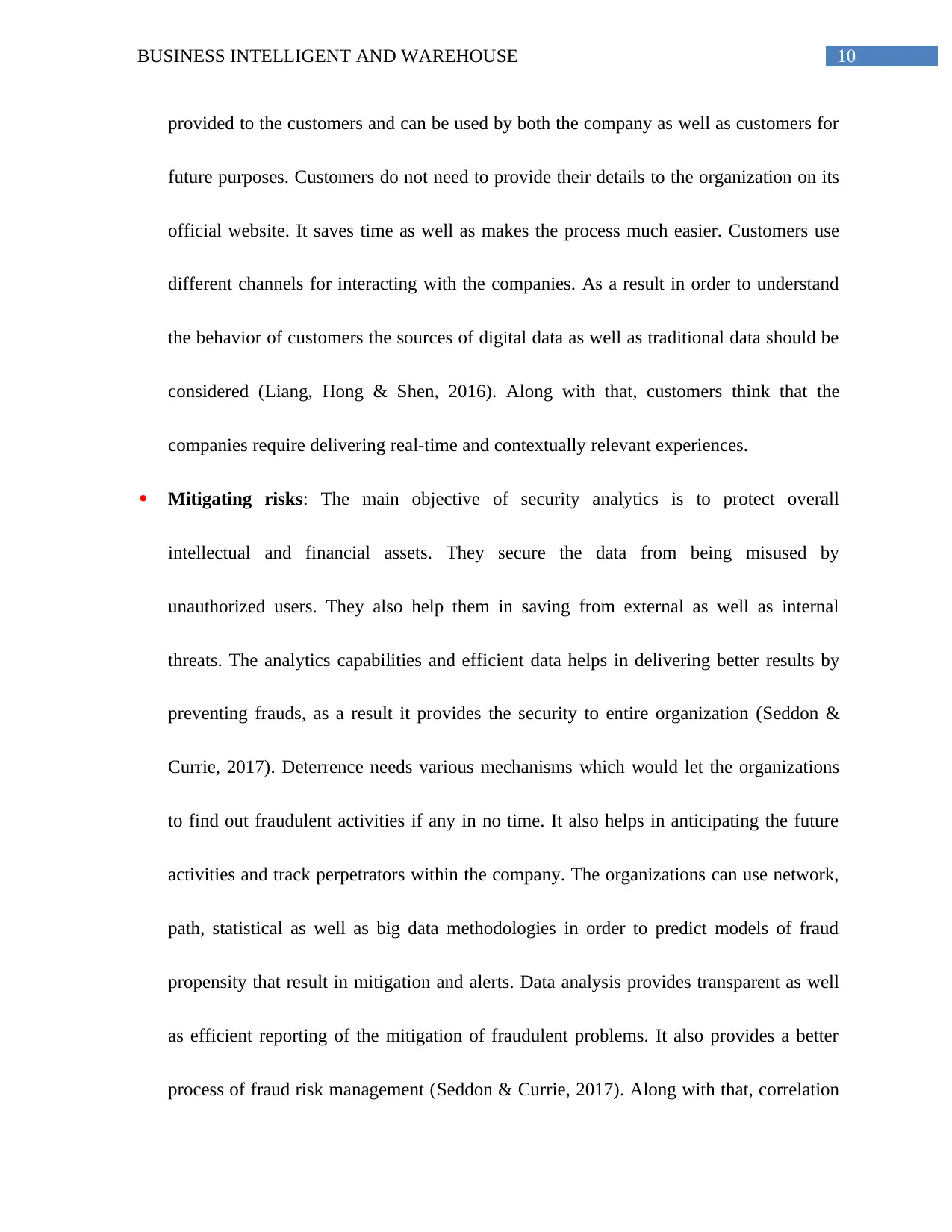
10BUSINESS INTELLIGENT AND WAREHOUSE
provided to the customers and can be used by both the company as well as customers for
future purposes. Customers do not need to provide their details to the organization on its
official website. It saves time as well as makes the process much easier. Customers use
different channels for interacting with the companies. As a result in order to understand
the behavior of customers the sources of digital data as well as traditional data should be
considered (Liang, Hong & Shen, 2016). Along with that, customers think that the
companies require delivering real-time and contextually relevant experiences.
Mitigating risks: The main objective of security analytics is to protect overall
intellectual and financial assets. They secure the data from being misused by
unauthorized users. They also help them in saving from external as well as internal
threats. The analytics capabilities and efficient data helps in delivering better results by
preventing frauds, as a result it provides the security to entire organization (Seddon &
Currie, 2017). Deterrence needs various mechanisms which would let the organizations
to find out fraudulent activities if any in no time. It also helps in anticipating the future
activities and track perpetrators within the company. The organizations can use network,
path, statistical as well as big data methodologies in order to predict models of fraud
propensity that result in mitigation and alerts. Data analysis provides transparent as well
as efficient reporting of the mitigation of fraudulent problems. It also provides a better
process of fraud risk management (Seddon & Currie, 2017). Along with that, correlation
provided to the customers and can be used by both the company as well as customers for
future purposes. Customers do not need to provide their details to the organization on its
official website. It saves time as well as makes the process much easier. Customers use
different channels for interacting with the companies. As a result in order to understand
the behavior of customers the sources of digital data as well as traditional data should be
considered (Liang, Hong & Shen, 2016). Along with that, customers think that the
companies require delivering real-time and contextually relevant experiences.
Mitigating risks: The main objective of security analytics is to protect overall
intellectual and financial assets. They secure the data from being misused by
unauthorized users. They also help them in saving from external as well as internal
threats. The analytics capabilities and efficient data helps in delivering better results by
preventing frauds, as a result it provides the security to entire organization (Seddon &
Currie, 2017). Deterrence needs various mechanisms which would let the organizations
to find out fraudulent activities if any in no time. It also helps in anticipating the future
activities and track perpetrators within the company. The organizations can use network,
path, statistical as well as big data methodologies in order to predict models of fraud
propensity that result in mitigation and alerts. Data analysis provides transparent as well
as efficient reporting of the mitigation of fraudulent problems. It also provides a better
process of fraud risk management (Seddon & Currie, 2017). Along with that, correlation
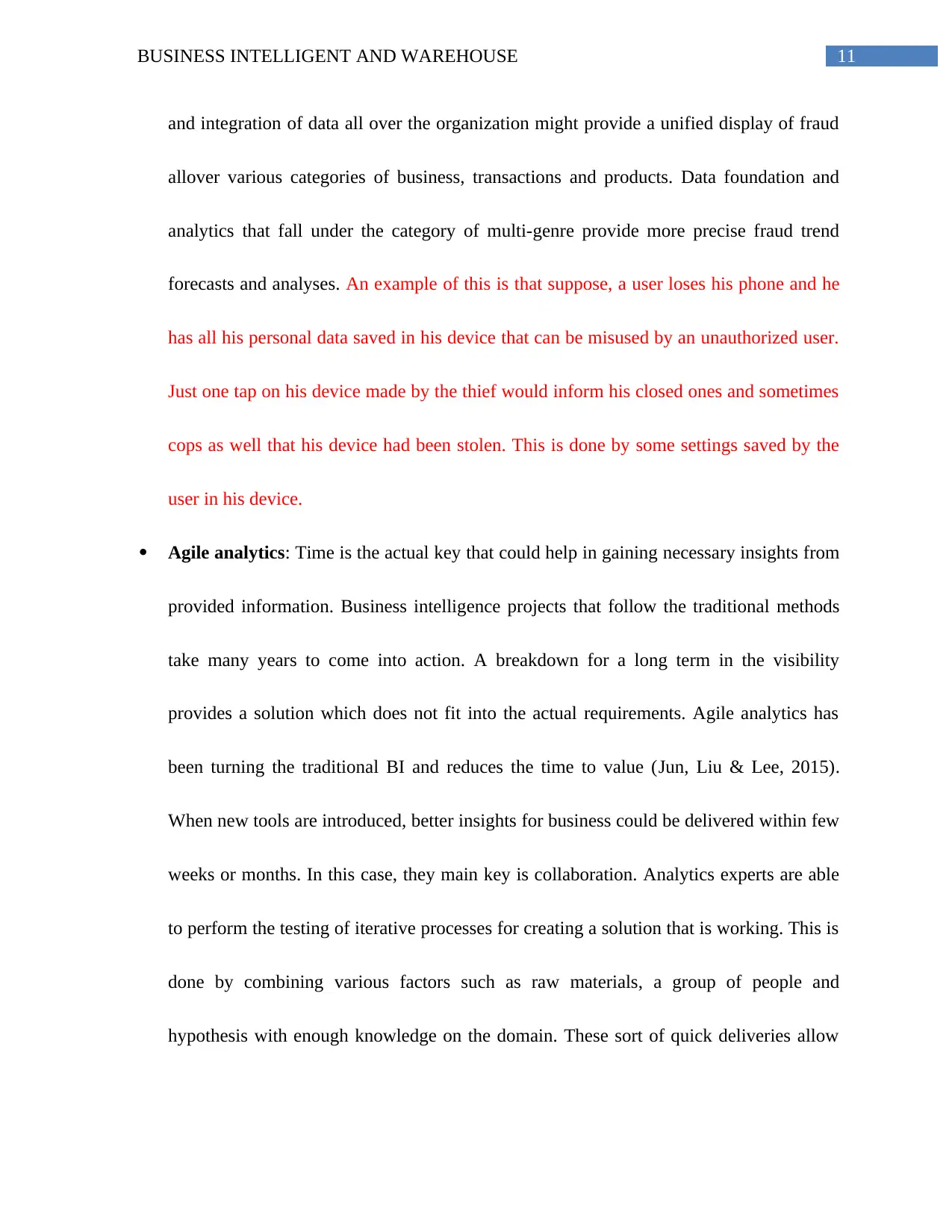
11BUSINESS INTELLIGENT AND WAREHOUSE
and integration of data all over the organization might provide a unified display of fraud
allover various categories of business, transactions and products. Data foundation and
analytics that fall under the category of multi-genre provide more precise fraud trend
forecasts and analyses. An example of this is that suppose, a user loses his phone and he
has all his personal data saved in his device that can be misused by an unauthorized user.
Just one tap on his device made by the thief would inform his closed ones and sometimes
cops as well that his device had been stolen. This is done by some settings saved by the
user in his device.
Agile analytics: Time is the actual key that could help in gaining necessary insights from
provided information. Business intelligence projects that follow the traditional methods
take many years to come into action. A breakdown for a long term in the visibility
provides a solution which does not fit into the actual requirements. Agile analytics has
been turning the traditional BI and reduces the time to value (Jun, Liu & Lee, 2015).
When new tools are introduced, better insights for business could be delivered within few
weeks or months. In this case, they main key is collaboration. Analytics experts are able
to perform the testing of iterative processes for creating a solution that is working. This is
done by combining various factors such as raw materials, a group of people and
hypothesis with enough knowledge on the domain. These sort of quick deliveries allow
and integration of data all over the organization might provide a unified display of fraud
allover various categories of business, transactions and products. Data foundation and
analytics that fall under the category of multi-genre provide more precise fraud trend
forecasts and analyses. An example of this is that suppose, a user loses his phone and he
has all his personal data saved in his device that can be misused by an unauthorized user.
Just one tap on his device made by the thief would inform his closed ones and sometimes
cops as well that his device had been stolen. This is done by some settings saved by the
user in his device.
Agile analytics: Time is the actual key that could help in gaining necessary insights from
provided information. Business intelligence projects that follow the traditional methods
take many years to come into action. A breakdown for a long term in the visibility
provides a solution which does not fit into the actual requirements. Agile analytics has
been turning the traditional BI and reduces the time to value (Jun, Liu & Lee, 2015).
When new tools are introduced, better insights for business could be delivered within few
weeks or months. In this case, they main key is collaboration. Analytics experts are able
to perform the testing of iterative processes for creating a solution that is working. This is
done by combining various factors such as raw materials, a group of people and
hypothesis with enough knowledge on the domain. These sort of quick deliveries allow
⊘ This is a preview!⊘
Do you want full access?
Subscribe today to unlock all pages.

Trusted by 1+ million students worldwide
1 out of 23
Related Documents
Your All-in-One AI-Powered Toolkit for Academic Success.
+13062052269
info@desklib.com
Available 24*7 on WhatsApp / Email
![[object Object]](/_next/static/media/star-bottom.7253800d.svg)
Unlock your academic potential
Copyright © 2020–2025 A2Z Services. All Rights Reserved. Developed and managed by ZUCOL.





